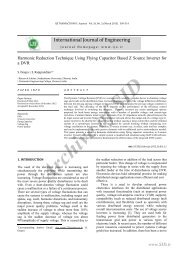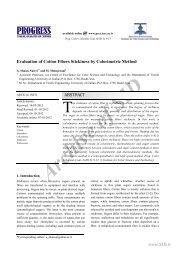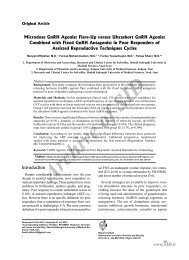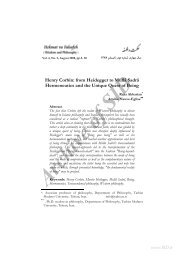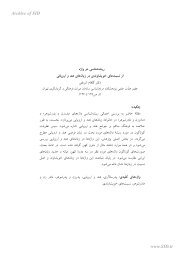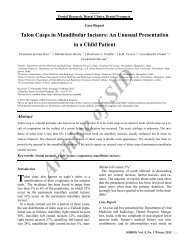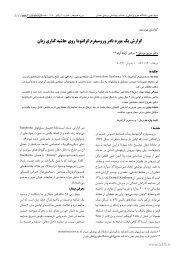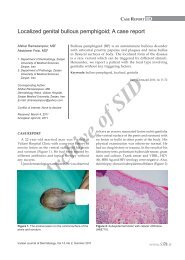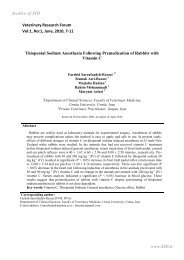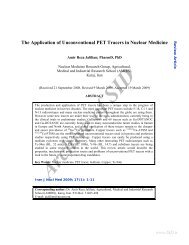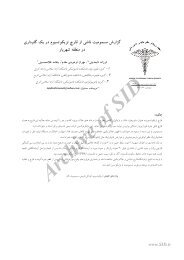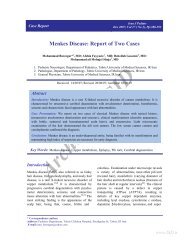the effect of three irrigants on the coronal leakage of the root canals ...
the effect of three irrigants on the coronal leakage of the root canals ...
the effect of three irrigants on the coronal leakage of the root canals ...
Create successful ePaper yourself
Turn your PDF publications into a flip-book with our unique Google optimized e-Paper software.
ORIGINAL ARTICLE<br />
The <str<strong>on</strong>g>effect</str<strong>on</strong>g> <str<strong>on</strong>g>of</str<strong>on</strong>g> <str<strong>on</strong>g>three</str<strong>on</strong>g> <str<strong>on</strong>g>irrigants</str<strong>on</strong>g> <strong>on</strong> <str<strong>on</strong>g>the</str<strong>on</strong>g> cor<strong>on</strong>al <strong>leakage</strong><br />
<str<strong>on</strong>g>of</str<strong>on</strong>g> <str<strong>on</strong>g>the</str<strong>on</strong>g> <strong>root</strong> <strong>canals</strong> system <str<strong>on</strong>g>irrigants</str<strong>on</strong>g><br />
Maryam Zare JahromiP<br />
P DDS, MS, Mehrdad BarekatainP P DDS, MS, Maziar EbrahimiP P DDS, and<br />
4<br />
Bahare AskariP P DDS<br />
1. Assistant Pr<str<strong>on</strong>g>of</str<strong>on</strong>g>essor <str<strong>on</strong>g>of</str<strong>on</strong>g> Endod<strong>on</strong>tics, Dental School, Islamic Azad University <str<strong>on</strong>g>of</str<strong>on</strong>g> Khorasgan, Isfahan, Iran.<br />
2. Assistant Pr<str<strong>on</strong>g>of</str<strong>on</strong>g>essor <str<strong>on</strong>g>of</str<strong>on</strong>g> Operative Dentistry, Dental School, Islamic Azad University <str<strong>on</strong>g>of</str<strong>on</strong>g> Khorasgan, Isfahan, Iran.<br />
3. Postgraduate Student <str<strong>on</strong>g>of</str<strong>on</strong>g> Endod<strong>on</strong>tics, Dental School, Islamic Azad University <str<strong>on</strong>g>of</str<strong>on</strong>g> Khorasgan, Isfahan, Iran.<br />
4. Dentist.<br />
IEJ -Volume 5, Number 3, Summer 2010<br />
1*<br />
Abstract<br />
Introducti<strong>on</strong>: The producti<strong>on</strong> <str<strong>on</strong>g>of</str<strong>on</strong>g> smear layer during canal instrumentati<strong>on</strong> is thought to<br />
increase cor<strong>on</strong>al micro<strong>leakage</strong> even after canal obturati<strong>on</strong>. Previous studies have shown that <str<strong>on</strong>g>the</str<strong>on</strong>g><br />
type <str<strong>on</strong>g>of</str<strong>on</strong>g> irrigant does not necessarily affect <str<strong>on</strong>g>the</str<strong>on</strong>g> seal <str<strong>on</strong>g>of</str<strong>on</strong>g> <str<strong>on</strong>g>the</str<strong>on</strong>g> obturati<strong>on</strong>. Our study aimed to evaluate<br />
<str<strong>on</strong>g>the</str<strong>on</strong>g> <str<strong>on</strong>g>effect</str<strong>on</strong>g> <str<strong>on</strong>g>of</str<strong>on</strong>g> <str<strong>on</strong>g>three</str<strong>on</strong>g> irrigati<strong>on</strong> soluti<strong>on</strong>s (MTAD, citric acid and EDTA/NaOCl) <strong>on</strong> <str<strong>on</strong>g>the</str<strong>on</strong>g> cor<strong>on</strong>al<br />
micro<strong>leakage</strong> <str<strong>on</strong>g>of</str<strong>on</strong>g> <strong>root</strong> <strong>canals</strong>.<br />
Materials and Methods: Fifty five intact single <strong>root</strong>ed teeth were instrumented and<br />
randomly divided into <str<strong>on</strong>g>three</str<strong>on</strong>g> experimental groups (15 teeth each) and two c<strong>on</strong>trol groups (5 teeth<br />
each). Final irrigati<strong>on</strong> was carried out with MTAD in group I, citric acid in group II, and<br />
EDTA/NaOCl in group III. EDTA/NaOCl was used for <str<strong>on</strong>g>the</str<strong>on</strong>g> negative c<strong>on</strong>trol group and saline<br />
irrigati<strong>on</strong> was carried out in <str<strong>on</strong>g>the</str<strong>on</strong>g> positive c<strong>on</strong>trol group. After lateral compacti<strong>on</strong> with guttapercha,<br />
<str<strong>on</strong>g>the</str<strong>on</strong>g> access cavities <str<strong>on</strong>g>of</str<strong>on</strong>g> <str<strong>on</strong>g>the</str<strong>on</strong>g> experimental specimens were restored with temporary<br />
restorative material. Temporary cement was not used in <str<strong>on</strong>g>the</str<strong>on</strong>g> positive c<strong>on</strong>trol group. In <str<strong>on</strong>g>the</str<strong>on</strong>g><br />
negative c<strong>on</strong>trol group, access cavities and foramen apices were sealed with glass i<strong>on</strong>omer.<br />
Micro<strong>leakage</strong> <str<strong>on</strong>g>of</str<strong>on</strong>g> samples was measured using <str<strong>on</strong>g>the</str<strong>on</strong>g> dye penetrati<strong>on</strong> technique. Data were analyzed<br />
with ANOVA and Tukey test to determine statistical differences between groups.<br />
Results: MTAD, citric acid and EDTA/NaOCl all had less micro<strong>leakage</strong> compared to normal<br />
saline. However, no difference was detected between <str<strong>on</strong>g>the</str<strong>on</strong>g> experimental groups.<br />
C<strong>on</strong>clusi<strong>on</strong>: In this study, all <str<strong>on</strong>g>three</str<strong>on</strong>g> groups dem<strong>on</strong>strated <str<strong>on</strong>g>effect</str<strong>on</strong>g>ive seal with gutta-percha<br />
obturati<strong>on</strong>. This is likely to be due to various factors including <str<strong>on</strong>g>the</str<strong>on</strong>g>ir ability to remove smear<br />
layer. [Iranian Endod<strong>on</strong>tic Journal 2010;5(3):121-4]<br />
Keywords: Citric acid, EDTA/NaOCl, Irrigati<strong>on</strong>, Micro<strong>leakage</strong>, MTAD, Smear layer.<br />
Received March 2010; accepted Jun 2010<br />
*Corresp<strong>on</strong>dence: Dr. Maryam Zare Jahromi, Dental School, Islamic Azad University <str<strong>on</strong>g>of</str<strong>on</strong>g> Khorasgan, Jei<br />
ave., Daneshgah ave., Isfahan, Iran. E-mail: hiva1378maryam@yahoo.com<br />
Archive <str<strong>on</strong>g>of</str<strong>on</strong>g> SID<br />
Introducti<strong>on</strong><br />
Endod<strong>on</strong>tic treatment success has been<br />
historically based <strong>on</strong> <str<strong>on</strong>g>effect</str<strong>on</strong>g>ive debridement,<br />
disinfecti<strong>on</strong>, and obturati<strong>on</strong> (1). Many<br />
researchers have stressed <str<strong>on</strong>g>the</str<strong>on</strong>g> <str<strong>on</strong>g>effect</str<strong>on</strong>g> <str<strong>on</strong>g>of</str<strong>on</strong>g> cor<strong>on</strong>al<br />
seal <strong>on</strong> <str<strong>on</strong>g>the</str<strong>on</strong>g> prognosis <str<strong>on</strong>g>of</str<strong>on</strong>g> <strong>root</strong> canal treatment in<br />
preventing bacterial penetrati<strong>on</strong> (2-5).<br />
Smear layer is a combinati<strong>on</strong> <str<strong>on</strong>g>of</str<strong>on</strong>g> organic and<br />
inorganic comp<strong>on</strong>ents formed during <strong>root</strong><br />
canal preparati<strong>on</strong>. This layer c<strong>on</strong>sists <str<strong>on</strong>g>of</str<strong>on</strong>g> dentin<br />
debris, pulp remnants, bacteria, endotoxin and<br />
sometimes restorative materials (5). It seems<br />
that removal <str<strong>on</strong>g>of</str<strong>on</strong>g> smear layer after <strong>root</strong> canal<br />
instrumentati<strong>on</strong> and before canal obturati<strong>on</strong><br />
2<br />
improves adaptati<strong>on</strong> <str<strong>on</strong>g>of</str<strong>on</strong>g> <strong>root</strong> filling materials to<br />
<str<strong>on</strong>g>the</str<strong>on</strong>g> canal walls, resulting in a superior seal and<br />
more predictable outcomes (6,7).<br />
Citric acids, phosphoric acid, sodium<br />
hypochlorite, EDTA, EDTAC and Carbamide<br />
Peroxide have all been used to remove <str<strong>on</strong>g>the</str<strong>on</strong>g><br />
smear layer (8). MTAD has been introduced<br />
as an irrigant. It has good antibacterial<br />
properties and great potential for removing <str<strong>on</strong>g>the</str<strong>on</strong>g><br />
smear layer (9).<br />
This type <str<strong>on</strong>g>of</str<strong>on</strong>g> irrigant was found to positively<br />
reduce cor<strong>on</strong>al micro<strong>leakage</strong>. In additi<strong>on</strong>,<br />
combining <str<strong>on</strong>g>irrigants</str<strong>on</strong>g> with smear layer removing<br />
etchants such as EDTA with NaOCl, and<br />
3<br />
121<br />
www.SID.ir
Zare Jahromi et al.<br />
chlorhexidine gel provided better cor<strong>on</strong>al seal<br />
when compared with NaOCl and chlorhexidine<br />
or distilled water al<strong>on</strong>e (10).<br />
Park et al. showed that <str<strong>on</strong>g>the</str<strong>on</strong>g> combinati<strong>on</strong> <str<strong>on</strong>g>of</str<strong>on</strong>g><br />
MTAD and NaOCl <str<strong>on</strong>g>effect</str<strong>on</strong>g>ively removed smear<br />
layer and significantly reduced cor<strong>on</strong>al <strong>leakage</strong>.<br />
However, no statistically difference was detected<br />
between MTAD and NaOCl/EDTA (11).<br />
A recent study has illustrated that <str<strong>on</strong>g>the</str<strong>on</strong>g>re is no<br />
difference in <str<strong>on</strong>g>the</str<strong>on</strong>g> smear layer removal efficacy<br />
between 17% EDTA, 10% citric acid and<br />
Smear Clear. However, 10% citric acid was<br />
less <str<strong>on</strong>g>effect</str<strong>on</strong>g>iveness in apical third compared to<br />
cor<strong>on</strong>al and middle third. N<strong>on</strong>e <str<strong>on</strong>g>of</str<strong>on</strong>g> <str<strong>on</strong>g>the</str<strong>on</strong>g><br />
materials used in <str<strong>on</strong>g>the</str<strong>on</strong>g> study were able to<br />
completely remove <str<strong>on</strong>g>the</str<strong>on</strong>g> smear layer (12).<br />
Ghoddusi et al. dem<strong>on</strong>strated that teeth treated<br />
with 17% EDTA or MTAD had no differences<br />
in bacterial penetrati<strong>on</strong> and micro<strong>leakage</strong>.<br />
However, <strong>leakage</strong> occurred in a prol<strong>on</strong>ged<br />
durati<strong>on</strong> compared to teeth irrigated with<br />
NaOCl (13).<br />
Therefore this study aimed to compare <str<strong>on</strong>g>the</str<strong>on</strong>g><br />
cor<strong>on</strong>al <strong>leakage</strong> <str<strong>on</strong>g>of</str<strong>on</strong>g> teeth treated with<br />
EDTA/NaOCl, MTAD or citric acid.<br />
Materials and Methods<br />
Fifty five human single <strong>root</strong>ed teeth with intact<br />
crown and <strong>root</strong> that did not have calcificati<strong>on</strong><br />
or severe <strong>root</strong> curvatures, were selected. T11Teeth<br />
were randomly divided into <str<strong>on</strong>g>three</str<strong>on</strong>g> groups <str<strong>on</strong>g>of</str<strong>on</strong>g> 15<br />
samples, i.e. groups I was irrigated with<br />
MTAD, group II with 10% citric acid, and<br />
group III with 5.25% NaOCl and 17% EDTA.<br />
Ten samples were equally divided between<br />
negative and positive c<strong>on</strong>trol groups (5 each).11T<br />
All specimens were cleaned using amalgam<br />
polishing burs and disinfected in 5.25%<br />
sodium hypochlorite (Daroogar, Tehran, Iran)<br />
122<br />
Archive <str<strong>on</strong>g>of</str<strong>on</strong>g> SID<br />
for 20 min. All samples were 11Tstored in a 0.9%<br />
normal saline soluti<strong>on</strong> until used.<br />
11TAfter access cavity preparati<strong>on</strong>, <strong>root</strong> <strong>canals</strong><br />
were prepared with crown-down technique<br />
using K-files (Mani, Ast<strong>on</strong>omia, Japan). The<br />
<strong>canals</strong> were instrumented to a size #40 master<br />
apical file (MAF) 1 mm short <str<strong>on</strong>g>of</str<strong>on</strong>g> <str<strong>on</strong>g>the</str<strong>on</strong>g> apex.<br />
Canal flaring was performed with number 1, 2,<br />
and 3 11TGates Glidden drills11T followed by number<br />
1, 2, 3 Peeso reamers. After two files were used<br />
<strong>canals</strong> were irrigated with 2 mL <str<strong>on</strong>g>of</str<strong>on</strong>g> 5.25%<br />
NaOCl throughout <str<strong>on</strong>g>the</str<strong>on</strong>g> procedure. After<br />
instrumentati<strong>on</strong>, radiographs were taken with<br />
<str<strong>on</strong>g>the</str<strong>on</strong>g> MAF in place to ensure proper length and<br />
positi<strong>on</strong>ing within <str<strong>on</strong>g>the</str<strong>on</strong>g> canal.<br />
11TBefore obturati<strong>on</strong>, <strong>canals</strong> in each experimental<br />
group were irrigated with 5 mL <str<strong>on</strong>g>of</str<strong>on</strong>g> <str<strong>on</strong>g>the</str<strong>on</strong>g> specific<br />
irrigant to remove <str<strong>on</strong>g>the</str<strong>on</strong>g> smear layer. The <strong>canals</strong><br />
were gently dried with paper points. After that,<br />
radiographs were taken with <str<strong>on</strong>g>the</str<strong>on</strong>g> master c<strong>on</strong>e in<br />
place to ensure proper length and positi<strong>on</strong>ing<br />
within <str<strong>on</strong>g>the</str<strong>on</strong>g> canal. The <strong>canals</strong> were 11Tlaterally<br />
c<strong>on</strong>densed with gutta-percha 11Tand AH26 sealer<br />
(Roth Internati<strong>on</strong>al Ltd., Chicago, IL) using<br />
finger spreader. The remnant gutta-percha was<br />
removed 11T2 mm below <str<strong>on</strong>g>the</str<strong>on</strong>g> cementoenamel<br />
juncti<strong>on</strong>11T with a hot excavator and <str<strong>on</strong>g>the</str<strong>on</strong>g>n vertical<br />
c<strong>on</strong>densati<strong>on</strong> was performed. All <str<strong>on</strong>g>the</str<strong>on</strong>g><br />
procedures were c<strong>on</strong>ducted by <strong>on</strong>e operator.<br />
11TAfter obturati<strong>on</strong>, radiographs were taken to<br />
check <str<strong>on</strong>g>the</str<strong>on</strong>g> quality and length <str<strong>on</strong>g>of</str<strong>on</strong>g> <str<strong>on</strong>g>the</str<strong>on</strong>g> obturati<strong>on</strong>.<br />
Access cavities were sealed with a Z<strong>on</strong>alin<br />
temporary cement (Golchai, Tehran, Iran).<br />
Finally samples were covered with <str<strong>on</strong>g>three</str<strong>on</strong>g> layer<br />
<str<strong>on</strong>g>of</str<strong>on</strong>g> nail varnish from CEJ to <str<strong>on</strong>g>the</str<strong>on</strong>g> apex.<br />
11TIn <str<strong>on</strong>g>the</str<strong>on</strong>g> positive c<strong>on</strong>trol group, saline was used for<br />
final irrigati<strong>on</strong>. The <strong>root</strong> <strong>canals</strong> were obturated<br />
as <str<strong>on</strong>g>the</str<strong>on</strong>g> experimental groups; however, temporary<br />
restorati<strong>on</strong> was not used. Finally, outer surfaces<br />
were covered with <str<strong>on</strong>g>three</str<strong>on</strong>g> layer <str<strong>on</strong>g>of</str<strong>on</strong>g> nail varnish.<br />
11TIn negative c<strong>on</strong>trol group final irrigati<strong>on</strong> was<br />
performed with hypochlorite sodium followed<br />
by EDTA. Then, <str<strong>on</strong>g>the</str<strong>on</strong>g> <strong>canals</strong> were obturated by<br />
lateral compacti<strong>on</strong> using gutta-percha and<br />
AH26 sealer. The access cavity, foramen<br />
apical and surrounding areas <str<strong>on</strong>g>of</str<strong>on</strong>g> each specimen<br />
was sealed with glass i<strong>on</strong>omer. Subsequently,<br />
all teeth surfaces (including crown and <strong>root</strong>)<br />
were covered with <str<strong>on</strong>g>three</str<strong>on</strong>g> layer <str<strong>on</strong>g>of</str<strong>on</strong>g> nail varnish.<br />
º<br />
11TAfter two weeks storage in 37P PC saline, each<br />
sample was placed with <str<strong>on</strong>g>the</str<strong>on</strong>g> crown facing <str<strong>on</strong>g>the</str<strong>on</strong>g><br />
top <str<strong>on</strong>g>of</str<strong>on</strong>g> <str<strong>on</strong>g>the</str<strong>on</strong>g> tube in a test tube filled with<br />
methylene blue (Merck, Darmstadt, Germany).<br />
Tubes were centrifuged at 12000 rpm for 20<br />
min. Then vertical buccolingual secti<strong>on</strong> was<br />
made using a diam<strong>on</strong>d disc cutting in n<strong>on</strong>stop<br />
device (Bego, Berman, Germany).<br />
11The <strong>leakage</strong> <str<strong>on</strong>g>of</str<strong>on</strong>g> samples was measured with a<br />
stereomicroscope (100B, Loma, Russia). 11T Dye<br />
<strong>leakage</strong> mean was measured at two sides <str<strong>on</strong>g>of</str<strong>on</strong>g> <str<strong>on</strong>g>the</str<strong>on</strong>g><br />
canal walls11T. Data were analyzed with ANOVA<br />
test and pairwise comparis<strong>on</strong>s <str<strong>on</strong>g>of</str<strong>on</strong>g> groups were<br />
performed by post hoc Tukey tests11T.<br />
IEJ -Volume 5, Number 3, Summer 2010<br />
www.SID.ir
Table1. Distributi<strong>on</strong> <str<strong>on</strong>g>of</str<strong>on</strong>g> micro<strong>leakage</strong> in apical <str<strong>on</strong>g>of</str<strong>on</strong>g> <strong>root</strong> <strong>canals</strong><br />
Group<br />
Number <str<strong>on</strong>g>of</str<strong>on</strong>g><br />
Specimen<br />
Mean<br />
<str<strong>on</strong>g>of</str<strong>on</strong>g> <strong>leakage</strong><br />
Standard<br />
Deviati<strong>on</strong><br />
Min.<br />
<str<strong>on</strong>g>of</str<strong>on</strong>g> <strong>leakage</strong><br />
Max.<br />
<str<strong>on</strong>g>of</str<strong>on</strong>g> <strong>leakage</strong><br />
10% citric acid 15 10.64 3.99 4.64 20.26<br />
MTAD 15 9.87 2.55 5.52 15.13<br />
17% EDTA +<br />
5.25% NaOCl<br />
15 8.90 2.72 4.04 16.41<br />
Results<br />
The mean micro<strong>leakage</strong> and standard deviati<strong>on</strong><br />
<str<strong>on</strong>g>of</str<strong>on</strong>g> different groups are shown in Table 1.<br />
ANOVA test results showed that significant<br />
differences exist between groups (P0.05). However, MTAD, citric acid and<br />
EDTA/NaOCl groups had significant<br />
differences with both positive and negative<br />
c<strong>on</strong>trol groups (P
Zare Jahromi et al.<br />
significantly different. These findings may<br />
result from <str<strong>on</strong>g>the</str<strong>on</strong>g> inability <str<strong>on</strong>g>of</str<strong>on</strong>g> MTAD to remove<br />
<str<strong>on</strong>g>the</str<strong>on</strong>g> organic comp<strong>on</strong>ents <str<strong>on</strong>g>of</str<strong>on</strong>g> smear layer (11).<br />
In c<strong>on</strong>trast, Torabinejad et al. used MTAD in<br />
<str<strong>on</strong>g>the</str<strong>on</strong>g> canal after irrigati<strong>on</strong> with NaOCl, distilled<br />
water or 17% EDTA. They showed MTAD was<br />
able to remove most parts <str<strong>on</strong>g>of</str<strong>on</strong>g> smear layer but<br />
some organic comp<strong>on</strong>ent <str<strong>on</strong>g>of</str<strong>on</strong>g> <str<strong>on</strong>g>the</str<strong>on</strong>g> layer remained<br />
in <str<strong>on</strong>g>the</str<strong>on</strong>g> canal (9).<br />
Fur<str<strong>on</strong>g>the</str<strong>on</strong>g>rmore, some differences with o<str<strong>on</strong>g>the</str<strong>on</strong>g>r<br />
investigati<strong>on</strong>s may be due to <str<strong>on</strong>g>the</str<strong>on</strong>g> variety in<br />
materials and <str<strong>on</strong>g>the</str<strong>on</strong>g> methods. Overall, all<br />
experimental groups showed significantly lower<br />
cor<strong>on</strong>al micro<strong>leakage</strong> compared to positive<br />
c<strong>on</strong>trol group.<br />
C<strong>on</strong>clusi<strong>on</strong><br />
Irrigating <str<strong>on</strong>g>the</str<strong>on</strong>g> <strong>root</strong> canal system with soluti<strong>on</strong>s<br />
that can dissolve <str<strong>on</strong>g>the</str<strong>on</strong>g> smear layer, such as<br />
MTAD, citric acid, and EDTA (with NaOCl)<br />
will reduce cor<strong>on</strong>al micro<strong>leakage</strong> from <str<strong>on</strong>g>the</str<strong>on</strong>g><br />
obturated canal more efficiently than saline.<br />
Interestingly, n<strong>on</strong>e <str<strong>on</strong>g>of</str<strong>on</strong>g> <str<strong>on</strong>g>the</str<strong>on</strong>g> <str<strong>on</strong>g>irrigants</str<strong>on</strong>g> were found<br />
to be significantly superior.<br />
References<br />
1. Cohen S, Hargreaves KM: Pathway <str<strong>on</strong>g>of</str<strong>on</strong>g> <str<strong>on</strong>g>the</str<strong>on</strong>g> Pulp,<br />
th<br />
9P P Editi<strong>on</strong>. St.Louis: CV Mosby, 2006: pp. 358.<br />
2. Kennedy WA, Walker WA 3rd, Gough RW.<br />
Smear layer removal <str<strong>on</strong>g>effect</str<strong>on</strong>g>s <strong>on</strong> apical <strong>leakage</strong>.14T J<br />
Endod14T 20T 1986;12:21-7.<br />
3. 9TVassiliadis L9T, 9TLiolios E9T, 9TKouvas V9T,<br />
9TEc<strong>on</strong>omides N9T. Effect <str<strong>on</strong>g>of</str<strong>on</strong>g> smear layer <strong>on</strong> cor<strong>on</strong>al<br />
micro<strong>leakage</strong>. 9TOral Surg Oral Med Oral Pathol<br />
Oral Radiol Endod9T 1996;82:315-20.<br />
4. Cergneux M, Ciucchi B, Dietschi JM, Holz J.<br />
124<br />
9The influence <str<strong>on</strong>g>of</str<strong>on</strong>g> <str<strong>on</strong>g>the</str<strong>on</strong>g> smear layer <strong>on</strong> <str<strong>on</strong>g>the</str<strong>on</strong>g> sealing<br />
ability <str<strong>on</strong>g>of</str<strong>on</strong>g> canal obturati<strong>on</strong>.9T Int Endod J<br />
1987;20:228-32.<br />
5. Gale MS. Cor<strong>on</strong>al micro<strong>leakage</strong>. 14TAnn R<br />
Australas Coll Dent Surg14T 20T 2000;15:299-305.<br />
6. McComb D, Smith DC. A preliminary scanning<br />
electr<strong>on</strong> microscopic study <str<strong>on</strong>g>of</str<strong>on</strong>g> <strong>root</strong> <strong>canals</strong> after<br />
endod<strong>on</strong>tic procedures. 14TJ Endod14T 20T 1975;1:238-42.<br />
7. Pashley DH. Smear layer: overview <str<strong>on</strong>g>of</str<strong>on</strong>g><br />
structure and functi<strong>on</strong>. 14TProc Finn Dent Soc14T 20T<br />
1992;88:215-24.<br />
8. Torabinejad M, Handysides R, Khademi AA,<br />
Bakland LK. Clinical implicati<strong>on</strong>s <str<strong>on</strong>g>of</str<strong>on</strong>g> <str<strong>on</strong>g>the</str<strong>on</strong>g> smear<br />
layer in endod<strong>on</strong>tics: a review. 14TOral Surg Oral Med<br />
Oral Pathol Oral Radiol Endod14T 20T 2002;94:658-66.<br />
9. Torabinejad M, Cho Y, Khademi AA,<br />
Bakland LK, Shabahang S. The <str<strong>on</strong>g>effect</str<strong>on</strong>g> <str<strong>on</strong>g>of</str<strong>on</strong>g> various<br />
c<strong>on</strong>centrati<strong>on</strong>s <str<strong>on</strong>g>of</str<strong>on</strong>g> sodium hypochlorite <strong>on</strong> <str<strong>on</strong>g>the</str<strong>on</strong>g><br />
ability <str<strong>on</strong>g>of</str<strong>on</strong>g> MTAD to remove <str<strong>on</strong>g>the</str<strong>on</strong>g> smear layer. 14TJ<br />
Endod14T 20T 2003;29:233-9.<br />
10. 9TVivacqua-Gomes N 9T, 9TFerraz CC9T, 9TGomes BP 9T,<br />
9TZaia AA9T, 9Teixeira FB9T, 9TSouza-Filho FJ9T. Influence<br />
<str<strong>on</strong>g>of</str<strong>on</strong>g> <str<strong>on</strong>g>irrigants</str<strong>on</strong>g> <strong>on</strong> <str<strong>on</strong>g>the</str<strong>on</strong>g> cor<strong>on</strong>al micro<strong>leakage</strong> <str<strong>on</strong>g>of</str<strong>on</strong>g><br />
laterally c<strong>on</strong>densed gutta-percha <strong>root</strong> fillings. 9TInt<br />
Endod J9T 2002;35:791-5.<br />
11. Park DS, Torabinejad M, Shabahang S. The<br />
<str<strong>on</strong>g>effect</str<strong>on</strong>g> <str<strong>on</strong>g>of</str<strong>on</strong>g> MTAD <strong>on</strong> <str<strong>on</strong>g>the</str<strong>on</strong>g> cor<strong>on</strong>al <strong>leakage</strong> <str<strong>on</strong>g>of</str<strong>on</strong>g><br />
obturated <strong>root</strong> <strong>canals</strong>.14T J Endod 14T 20T 2004;30:890-2.<br />
12. Khedmat S, Shokouhinejad N. 9TComparis<strong>on</strong> <str<strong>on</strong>g>of</str<strong>on</strong>g><br />
<str<strong>on</strong>g>the</str<strong>on</strong>g> efficacy <str<strong>on</strong>g>of</str<strong>on</strong>g> <str<strong>on</strong>g>three</str<strong>on</strong>g> chelating agents in smear<br />
layer removal.9T J Endod 2008;34:599-602.<br />
13. 9TGhoddusi J9T, 9TRohani A9T, 9TRashed T9T, 9TGhaziani P9T,<br />
9TAkbari M9T. An evaluati<strong>on</strong> <str<strong>on</strong>g>of</str<strong>on</strong>g> microbial <strong>leakage</strong> after<br />
using MTAD as a final irrigati<strong>on</strong>. 9TJ Endod9T<br />
2007;33:173-6.<br />
14. Lee YC, Yang SF, Hwang YF, Chueh LH,<br />
Chung KH. 9TMicro<strong>leakage</strong> <str<strong>on</strong>g>of</str<strong>on</strong>g> endod<strong>on</strong>tic temporary<br />
restorative materials.9T J Endod 1993;19:516-20.<br />
Archive <str<strong>on</strong>g>of</str<strong>on</strong>g> SID<br />
IEJ -Volume 5, Number 3, Summer 2010<br />
www.SID.ir



